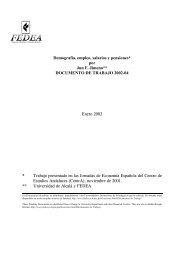The Evolution of Retirement by J. Ignacio Conde-Ruiz* Vincenzo ...
The Evolution of Retirement by J. Ignacio Conde-Ruiz* Vincenzo ...
The Evolution of Retirement by J. Ignacio Conde-Ruiz* Vincenzo ...
You also want an ePaper? Increase the reach of your titles
YUMPU automatically turns print PDFs into web optimized ePapers that Google loves.
similar result is obtained if we restrict to the activity rates <strong>of</strong> man (column (c)).<br />
To better understand the determinants <strong>of</strong> the level <strong>of</strong> pension expenditures<br />
and the role played <strong>by</strong> each <strong>of</strong> the identified variables, as pointed out <strong>by</strong> Jimeno<br />
(2002a, 2002b) we use the following identity:<br />
PENSEXP = NUMPENS ∗ AV P ENS<br />
which makes clear how the level <strong>of</strong> pension expenditures as percentage <strong>of</strong> GDP is<br />
the product <strong>of</strong> the number <strong>of</strong> pensioners as a proportion <strong>of</strong> total population and<br />
<strong>of</strong> the average pension in terms <strong>of</strong> GDP per capita. According to this decomposition,<br />
the role played <strong>by</strong> the demographic variable (the proportion <strong>of</strong> elderly in<br />
the population) and the retirement variables (the measures <strong>of</strong> early retirement)<br />
in explaining the level <strong>of</strong> pension expenditures can be better understand using<br />
two additional sets <strong>of</strong> regressions. Due to limited information on the number<br />
<strong>of</strong> pensioners and the average pension, we perform these regressions only using<br />
thesample<strong>of</strong>allcountries.<br />
First, we try to estimate the determinants <strong>of</strong> the number <strong>of</strong> pensioners,<br />
as shown in table 4.<br />
Clearly, countries where there are more elderly in the<br />
population have more pensioners (OLD is positively and significantly related<br />
to NUMPENS). Countries where there is more early retirement have also more<br />
pensioners (ACTOT is negatively and significantly related to PENSEXP in<br />
column (a) and DAC negatively and significantly in column (b)). This regression<br />
makes clear that both the proportion <strong>of</strong> elderly in total population and early<br />
retirement increase the level <strong>of</strong> pension expenditures through the increase <strong>of</strong><br />
the number <strong>of</strong> pensioners. Second, we estimate the impact <strong>of</strong> demographics and<br />
retirement on the level <strong>of</strong> average pension. Table 5 shows that neither aging<br />
(OLD) nor early retirement (DAC) are significant in explaining the average<br />
pension.<br />
To summarize, these simple results suggest that while more elderly and lower<br />
7






